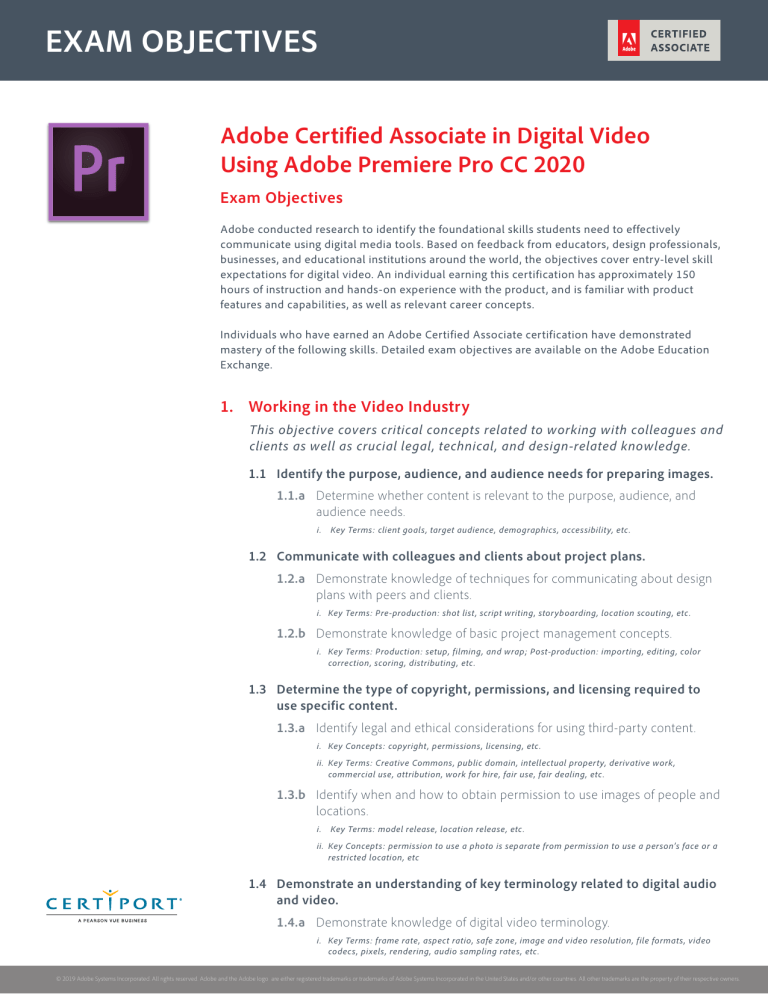
EXAM OBJECTIVES Adobe Certified Associate in Digital Video Using Adobe Premiere Pro CC 2020 Exam Objectives Adobe conducted research to identify the foundational skills students need to effectively communicate using digital media tools. Based on feedback from educators, design professionals, businesses, and educational institutions around the world, the objectives cover entry-level skill expectations for digital video. An individual earning this certification has approximately 150 hours of instruction and hands-on experience with the product, and is familiar with product features and capabilities, as well as relevant career concepts. Individuals who have earned an Adobe Certified Associate certification have demonstrated mastery of the following skills. Detailed exam objectives are available on the Adobe Education Exchange. 1. Working in the Video Industry This objective covers critical concepts related to working with colleagues and clients as well as crucial legal, technical, and design-related knowledge. 1.1 Identify the purpose, audience, and audience needs for preparing images. 1.1.a Determine whether content is relevant to the purpose, audience, and audience needs. i. Key Terms: client goals, target audience, demographics, accessibility, etc. 1.2 Communicate with colleagues and clients about project plans. 1.2.a Demonstrate knowledge of techniques for communicating about design plans with peers and clients. i. Key Terms: Pre-production: shot list, script writing, storyboarding, location scouting, etc. 1.2.b Demonstrate knowledge of basic project management concepts. i. Key Terms: Production: setup, filming, and wrap; Post-production: importing, editing, color correction, scoring, distributing, etc. 1.3 Determine the type of copyright, permissions, and licensing required to use specific content. 1.3.a Identify legal and ethical considerations for using third-party content. i. Key Concepts: copyright, permissions, licensing, etc. ii. Key Terms: Creative Commons, public domain, intellectual property, derivative work, commercial use, attribution, work for hire, fair use, fair dealing, etc. 1.3.b Identify when and how to obtain permission to use images of people and locations. i. Key Terms: model release, location release, etc. ii. Key Concepts: permission to use a photo is separate from permission to use a person’s face or a restricted location, etc 1.4 Demonstrate an understanding of key terminology related to digital audio and video. 1.4.a Demonstrate knowledge of digital video terminology. i. Key Terms: frame rate, aspect ratio, safe zone, image and video resolution, file formats, video codecs, pixels, rendering, audio sampling rates, etc. © 2019 Adobe Systems Incorporated. All rights reserved. Adobe and the Adobe logo are either registered trademarks or trademarks of Adobe Systems Incorporated in the United States and/or other countries. All other trademarks are the property of their respective owners. 1.4.b Demonstrate knowledge of how color is managed in digital video. i. Key Terms: white balance, color grading, etc. 1.4.c Understand and use key terms related to video and audio production. i. Key Terms: Audio: clipping, levels, microphones (shotgun, handheld, wireless, etc.), natural/ambient sound, room tone, Foley sound, etc. Video: aperture, shutter speed, ISO, lens types (zoom, prime/fixed, telephoto, etc.), tripod, dolly, etc. 1.5 Demonstrate knowledge of basic design principles and best practices employed in the video industry. 1.5.a Communicate visually using standard film/video techniques. i. Key Concepts: rule of thirds; following the action; leading in and out of shots to give editors time to cut; matching shots; zooms and pans; wide vs. tight shots; establishing shots vs. closing shots; shooting B-roll footage; a coverage model that uses a master wide shot as a base image; head room; cut-off points; L cuts; room tones, etc. 1.5.b Identify general design principles and guidelines for editing video. i. Key Concepts: sequencing shots, cuts, transitions, appropriate video for specific uses, good typography and legibility of titles, fade, cuts, dissolves, wipes, chroma key, compositing, audio levels, background music, narration, sound effects, still images used in video (file formats and image specifications), titles, lower thirds, roll, crawl, etc. 1.5.c Define common photographic and cinematic composition terms and principles. i. Key Terms: aspect ratio, rule of thirds, foreground, background, color, tone, contrast, cropping, depth of field, field of view, white balance, etc. 1.5.d Define types of shots and give examples of when and why to use them. i. Types of shots include: close-up (CU), extreme close-up (ECU), medium close-up (MCU), medium shot (MS), wide shot (WS), long shot (LS), extreme long shot (ELS), background (BG or bg), foreground (FG or fg), over-the-shoulder (OTS), point of view (POV), cutaway, etc. 2. Project Setup and Interface This objective covers the interface setup and program settings that assist in an efficient and effective workflow, as well as knowledge about ingesting digital assets for a project. 2.1 Set appropriate project settings for video. 2.1.a Set appropriate project settings for video. i. Key Concepts: project location on drive(s), sequence settings, scratch disk, etc. 2.1.b Create a sequence that matches the project requirements. i. Key Concepts: frame rate, resolution, etc. 2.2 Navigate, organize, and customize the application workspace. 2.2.a Identify and manipulate elements of the Premiere Pro interface. i. Key Concepts: menus, panels, toolbars, sequences, Program and Source Monitors, Button Editor, navigating, zooming, etc. 2.2.b Organize and customize the workspace. i. Key Concepts: using/switching default workspaces; showing, hiding, nesting, and docking panels; using live workspaces and the Workspace Switcher, shortcuts, and menus; customizing, saving, and resetting workspaces; etc. 2.2.c Configure application preferences. i. Key Settings: Auto-save, General (bin settings, default scale to frame size and transition duration), etc. 2.3 Use non-visible design tools in the interface to aid in video workflow. 2.3.a Navigate a project. i. Key Concepts: panning, zooming, playing, pausing, keyboard shortcuts ( jkl, spacebar, backslash, tilde), etc. © 2019 Adobe Systems Incorporated. All rights reserved. Adobe and the Adobe logo are either registered trademarks or trademarks of Adobe Systems Incorporated in the United States and/or other countries. All other trademarks are the property of their respective owners. 2.3.b Use timeline markers. i. Key Concepts: time indicators, markers, keyframes, audio/video rubber bands, etc. 2.3.c Use guides. i. Key Concepts: title safe areas, action safe areas, etc. 2.4 Import assets into a project. 2.4.a Import media from various sources i. Key Concepts: file, camera, importing layers in .psd or .ai files, dynamic linking, all files are linked, dragging and dropping, creating a proxy on import, etc. 2.4.b Manage assets in a Premiere Pro project. i. Key Concepts: relinking files, updating file locations for missing/moved/updated media, organizing projects in bins, thumbnails vs list view, metadata, renaming a sequence, removing unused assets, Project Manager, etc. 3. Organizing Video Projects This objective covers video project structure including layers, tracks, and assets for efficient workflow. 3.1 3.1 Use the Timeline panel to manage video and audio tracks. 3.1.a Use the Timeline panel to manage tracks. i. Key Concepts: clips vs tracks, adding/deleting tracks, locking/unlocking tracks, renaming tracks and sequences, targeting a track, expanding a track in the timeline, etc. 3.1.b Manage sequences in a complex project. i. Key Concepts: nesting sequences, using sequences to control effects over multiple clips, linking/unlinking audio and video clips, syncing audio with video clips, etc. 3.2 Modify basic track visibility and audio levels. 3.2.a Adjust a track’s visibility and audio levels. i. Key Concepts: hiding/showing tracks, muting tracks, setting solo tracks, etc. 4. Creating and Modifying Visual Elements This objective covers core tools and functionality of the application, as well as tools that affect the sequences within the project. 4.1 Use core tools and features to edit audio and video. 4.1.a Create a video rough-cut using a variety of tools and panels. i. Key Tools: timeline, Source Monitor, Program Monitor, assembly cuts, rough cuts, cutsonly edit, creating In and Out points for a rough cut, Razor tool; inserting, overwriting, lifting, and extracting clips; creating a multi-cam source sequence; etc. 4.1.b Place images and video into a sequence. i. Key Concepts: frame duration, automating to sequence, etc. 4.2 Add and animate titles and modify title properties. 4.2.a Create superimposed text and shapes in a video sequence. i. Key Concepts: point text, paragraph text, path text, applying the Show Video Behind Title function, etc. 4.2.b Use appropriate character settings in a title. i. Key Settings: font, size, style, kerning, tracking, leading, horizontal and vertical scale, etc. 4.2.c Use appropriate paragraph settings in a title. i. Key Settings: alignment, line length, readability, hierarchy, using color to enhance legibility, etc. 4.2.d Animate title elements. i. Key Concepts: animating text to start and stop off-screen by using keyframes, adjusting roll/crawl speed, etc. © 2019 Adobe Systems Incorporated. All rights reserved. Adobe and the Adobe logo are either registered trademarks or trademarks of Adobe Systems Incorporated in the United States and/or other countries. All other trademarks are the property of their respective owners. 4.3 Trim footage for use in sequences. 4.3.a Resize clips using a variety of tools. i. Key Terms: adjusting scale, aspect ratio, or frame size; letterboxing; adjusting for mixed aspect ratios; using vertically shot video from phones; etc. 4.3.b Modify and refine clip trims using various methods. i. Key Concepts: adjusting In and Out points to existing footage, J-cut, L-cut, multi-camera editing, etc. ii. Key Tools: Rolling Edit tool, Ripple Edit tool, Slip tool, Slide tool, etc. 4.4 Transform digital media within a project. 4.4.a Modify clip settings. i. Key Concepts: labeling, renaming, setting poster frame, create a proxy of an existing clip, etc. 4.4.b Change the speed or direction of a video clip. i. Key Concepts: varying the speed throughout a video clip, including by creating a freeze frame; changing the speed or direction; Rate Stretch tool; time remapping; etc. 4.4.c Adjust the audio of a video clip. i. Key Concepts: audio gain, channel remapping, normalize, etc. 4.5 Use basic editing techniques and effect presets to manipulate digital audio and video. 4.5.a Use basic auto-correction methods and tools. i. Key Tools: color grading, white balance, auto tone, audio normalization, etc. ii. NOTE: Curves, HSL, secondary color are out of scope 4.5.b Use audio and video effects presets. i. Key Tools: quick cuts or fades, cutting to B-roll to hide a cut, video transitions, etc. 4.5.c Apply and adjust effects presets on multiple clips in separate tracks by using adjustment layers. i. Key Tools: adjusting the length of the adjustment layer, applying the effect preset to the adjustment layer, etc. 4.6 Use Effect Controls to modify video in a sequence. 4.6.a Modify video effect settings. i. Key Concepts: adding and adjusting video effect properties and keyframes in the Effect Controls panel, etc. 4.6.b Apply and adjust video motion effects. i. Key Concepts: adjusting clip settings over time by using keyframes to control scale, position, visual effects, opacity rubber band on timeline, etc. 4.6.c Composite video tracks. i. Key Concepts: keying (luma/chroma), opacity, masking, mattes, alpha channel, picture-inpicture, using nesting to apply effects to multiple tracks, interpolation, etc. 4.7 Manage audio in a video sequence. 4.7.a Add audio to a sequence. i. Key Concepts: synchronizing, linking, replacing, merging clips, mono vs. stereo tracks, voice-over recording, etc. 4.7.b Adjust audio on the timeline or using the Effect Controls panel. i. Key Concepts: adding audio transitions and effects; adding, removing, and adjusting keyframes (including rubber band), etc. © 2019 Adobe Systems Incorporated. All rights reserved. Adobe and the Adobe logo are either registered trademarks or trademarks of Adobe Systems Incorporated in the United States and/or other countries. All other trademarks are the property of their respective owners. 5. Publishing Digital Media This objective covers publishing and exporting video and audio sequences in multiple formats for various publishing platforms. 5.1 Prepare video and audio sequences for publishing to web, screen, and other digital devices. 5.1.a Check a project for errors and project specifications i. Key Concepts: gaps in timeline, audio levels, exposure levels, spelling, resolution, title safe area, project size, etc.. 5.2 Export and archive video and audio sequences. 5.2.a Export a clip, range of frames, or an entire sequence. i. Key Concepts: file formats/video codecs, file names, export locations, exporting only audio or video, etc. 5.2.b Export a single frame. i. Key Concepts: file format, file name, export location, etc. 5.2.c Export using the Adobe Media Encoder. i. Key Concepts: batch processing, more than one target screen size or playback device, multiple formats, etc. 5.2.d Archive a project. i. Key Tool: Project Manager NOTE: All key items (Key Terms, Key Tools, Key Concepts, and Key Settings) are examples and not a comprehensive list. Changes in the industry or application may necessitate coverage of items not listed that apply to the Target Candidate description for the Adobe Certified Associate program. © 2020 Adobe Systems Incorporated. All rights reserved. Adobe and the Adobe logo are either registered trademarks or trademarks of Adobe Systems Incorporated in the United States and/or other countries. All other trademarks are the property of their respective owners.


